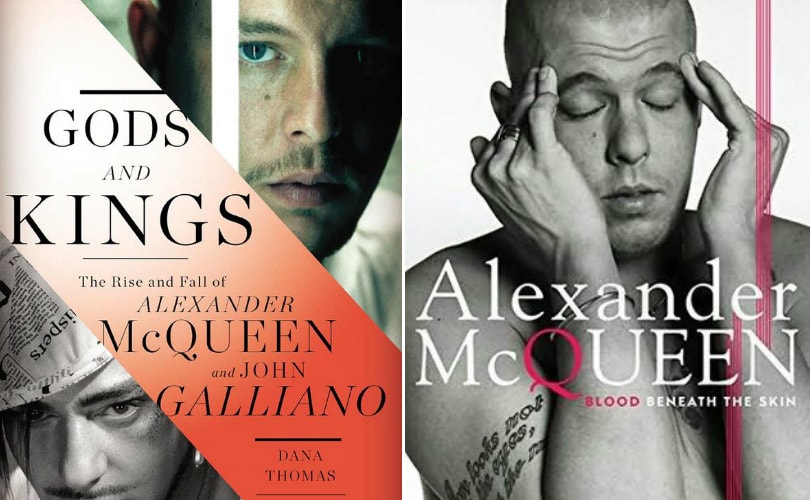Alexander McQueen and John Galliano: forged in excess!
It seems fitting that two books celebrating – and analyzing – the influence of fashion gods Alexander McQueen and John Galliano should come out as the Oscars kick off the red carpet season. If anyone doubts the importance of these designers, they need only glance at the picture sections of both biographies to see their impact on Hollywood and beyond.
Here’s
Nicole Kidman in that incredible chartreuse Chinoiserie gown by Galliano
at the Academy Awards in 1997. Here’s Galliano at a Metropolitan Museum
of Art’s Costume Institute gala with the Princess of Wales wearing his
first official design for Dior in 1996. Here’s McQueen with Kate Moss,
Naomi Campbell, Helena Christensen and any other model you can think of.
McQueen might not have actually designed the most talked about red
carpet dress of the 21st century but he lent his name to it when Kate
Middleton chose his successor Sarah Burton to design her wedding dress,
the year following his death.
That
said, as Dana Thomas makes clear in Gods and Kings, the glossy surface
is only a small part of the story. Thomas, a style writer for The
Washington Post and Newsweek, has spoken to more than 100 fashion
insiders to put together a portrait of an era dominated, in her account,
by these two uncontrollable and wild talents. Her story can be read as a
bitter criticism of the fashion world: she depicts both designers as
fiercely self-destructive, and working in an industry where that was
encouraged, indulged and exploited.
She charts the “fashion moment” defined by Galliano and McQueen from
Galliano’s St Martins graduation show in 1984 (a crazed riot of French
Revolution-inspired dandies with candyfloss hair and red, white and blue
rosettes) to McQueen’s suicide in February 2010 and Galliano’s
dismissal from the house of Dior a year later. (He was fired for making
anti-semitic remarks.) During this period the fashion industry was
transformed. “When Galliano first started back in the mid-Eighties, he
produced two collections annually. At the time of his termination in
2011, he was overseeing – at the Dior and John Galliano brands combined –
an astounding 32 collections a year.” It’s not a recipe for mental
stability. 
Thomas’s narrative flits
deftly between the “parallel professional journeys” of two men with a
similar rebellious streak. Galliano was born in Gibraltar and raised in
south London, his father a plumber, his mother a flamenco teacher.
McQueen was brought up in Lewisham, his mother also a teacher, his
father a taxi driver. Both were driven to celebrate and escape their
class: proud of their roots but also surrounding themselves with people
from the opposite end of the spectrum.
What’s interesting about Thomas’s account is that she doesn’t shy
away from the nasty bits: she paints both Galliano and McQueen as
intensely difficult people – bullying, drug-abusing narcissists. But she
also brings out the benefits of a designer’s capricious nature: these
people create “moments” and bring the wow factor.
On the hunt
for a successor for Galliano at Dior (now filled by Raf Simons), one
source tells Thomas that the stakes have got too high now that fashion
has become corporate: “Dior is a serious business, and they are
permanently turned in circles around what to do. They are afraid. Really
afraid. There is too much money in play.” Fashion, she concludes, “has
grown into a monolith that has no time or patience for imaginative young
designers”. Now there is “no poetry, no heart”.

Andrew Wilson’s
heartbreaking biography of McQueen takes an unflinching look at the
personal price McQueen paid for this supposed poetry. This seems like a
fan’s book at first glance – “written with the support of the McQueen
family” – but it’s a wonderfully readable and well-researched account.
There is plenty to gawp at. McQueen had a death wish in terms of both
drugs and tantrums. The tale of his friendship with Isabella Blow, the
aristocrat stylist who “discovered” him, is emblematic of many episodes
in his life: crazed passion and obsession intermingled with abuse and
hatred.
“There was some sort of psychosexual relationship between the
two of them. She was completely enamoured of him and his work, and I
think he wanted to punish her.” He once made fun of her by cutting two
holes in a muslin bag and giving it to her as a dress. “I love this,
darling!” she cooed. He burst out laughing as soon as she left the room.
Wilson paints McQueen as an intensely complex but ultimately
likeable person with a dark side that eventually destroyed him. The way
the story is told, there is a certain inevitability to McQueen’s fate.
But it seems deeply tragic that he killed himself a week after his
mother’s death, three years after the suicide of his one-time mentor
Blow.

Despite all the outrageous episodes, Wilson’s coup is to
make McQueen seem human, tortured by his genius. Both books give the
impression that the fashion industry is good at allowing people to be
bonkers, but then doesn’t know what to do with them. It almost makes
unpoetic commercialism seem tempting. 


No comments:
Post a Comment